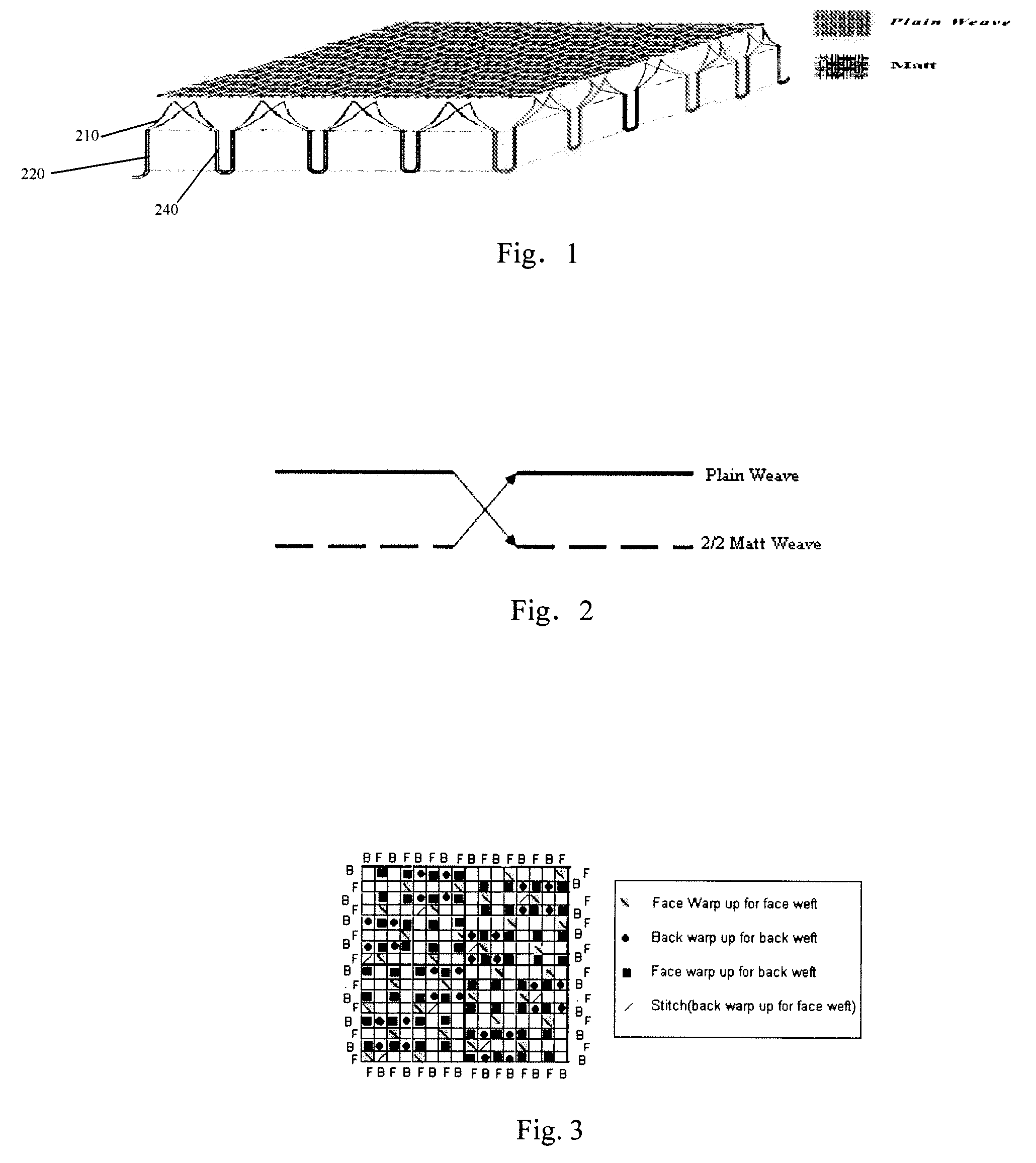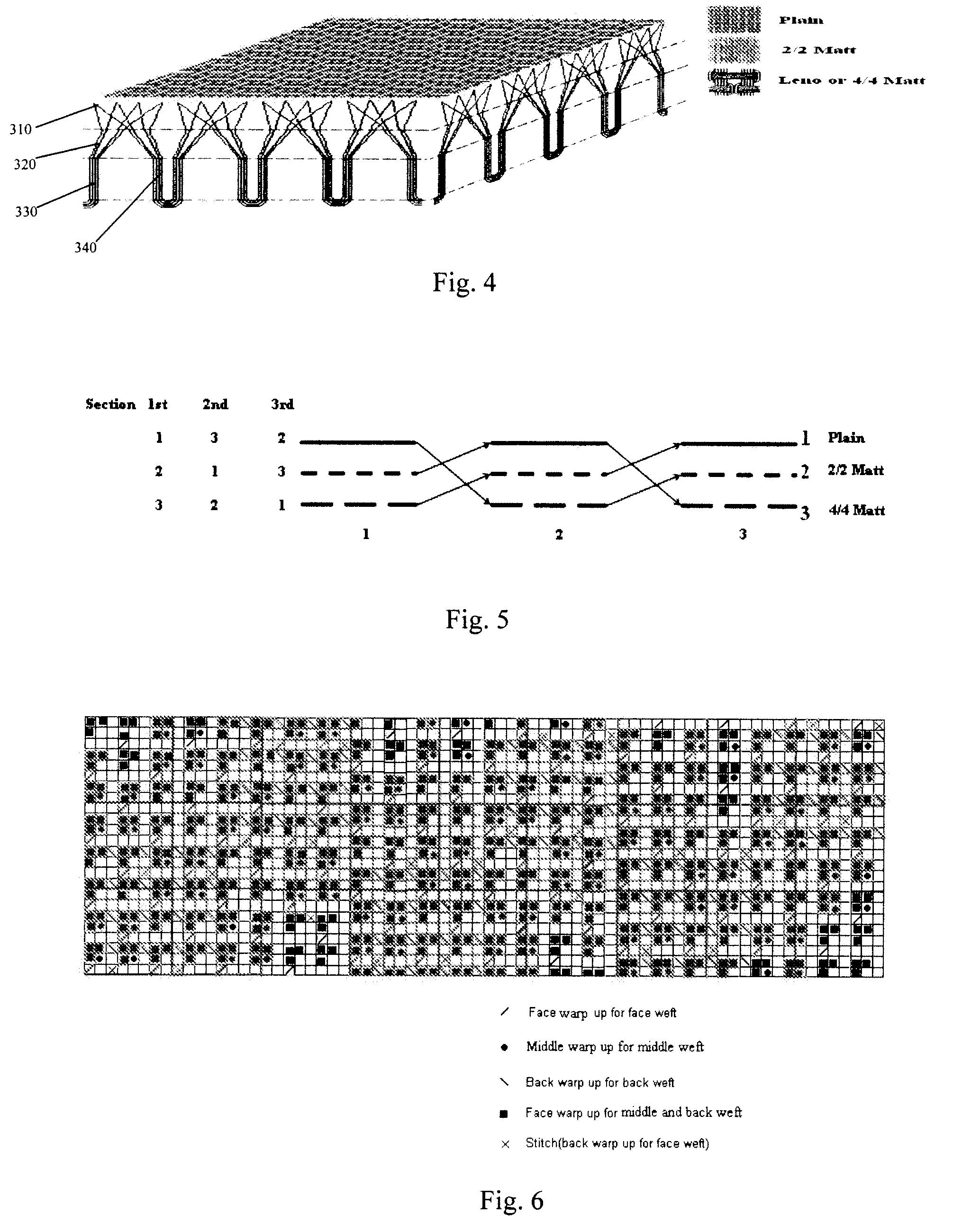Fabric stimulating the plant structure for moisture management
a plant structure and fabric technology, applied in the field of fabrics, can solve the problems of limited liquid water transport function of this fabric, uncomfortable wearer feeling of wet and cold, and limited liquid water transport properties, and achieve excellent water transport properties, keep wearer cool and dry
- Summary
- Abstract
- Description
- Claims
- Application Information
AI Technical Summary
Benefits of technology
Problems solved by technology
Method used
Image
Examples
first embodiment
[0022]FIG. 1 is a schematic structural view of a two-layer fabric according to the invention.
[0023]As shown in FIG. 1, the fabric according to the first embodiment of the present invention is a woven fabric having two layers; the bottom layer 220 in contact with skin is a matt structure, in which two yarns are grouped together to form a plurality of stem-like fabric units 240, which are respectively arranged in rows. The fabric unit 240, i.e. the “two-yarn stems” split into single yarns in the top layer 210, which is a plain weave structure. The splitting simulates the branching in the structure of the plant, which creates a greater surface area to volume ratio.
[0024]A method for preparing the two-layers fabric according to the first embodiment of the present invention is as follows:
[0025]In the two layers fabric as shown in FIG. 2, both warp and weft yarns in the bottom and top layer interchanges. As the two yarn groups move from the bottom layer to the top layer, they split into s...
second embodiment
[0027]As shown in FIG. 4, the fabric according to the present invention is a woven fabric having three layers; the bottom layer 330 in contact with skin is a 4×4 matt structure, in which four or more yams are grouped together to form a plurality of stem-like fabric units 340, which are respectively arranged in rows. The fabric unit 340, i.e. the “four-yam stem” split into “two-yam branches” in the middle layer 320 locating above the bottom layer 330, which then form a 2×2 matt structure simulating the branching in the structure of plant. The top layer 310 locating above the middle layer 320 is a plain weave structure, in which said yarns separate at the top layer 310 so as to obtain a greater surface area to volume ratio.
[0028]A method for producing the three layers fabric according to the first embodiment of the present invention is as follows:
[0029]In the three layers fabric, as shown in FIG. 5, the weft yarns interchanged from the bottom layer to the middle layer and finally to t...
working example
[0033
[0034]Using polyester warp and various types of weft yarns (viz. cotton, Coolmax, Thermolite), four two-layer fabrics and fifteen three-layer fabrics were produced. Detailed parameters of the fabrics are shown in Table-1. Detailed results of the MMT test for all the fabrics are shown in the Table-2.
TABLE 1Particulars of Different Fabric SamplesWeightThicknessS. no.Fabric Design and constructionWarp YarnWeft Yarnkg / mt−2(×10−3 mt)EPcmPPcmTwo Layer Structure1Plant structure(F-Plain, B-2 / 2 Matt)11.11 Tex polyester7.38 Tex 100% Cotton168.70.56264862Two layer interchanged plain11.11 Tex polyester7.38 Tex Cotton Yarn157.70.56864853Plant structure(F-Plain, B-2 / 2 Matt)11.11 Tex polyester19.76tex / 100% coolmax226.50.66965644Two layer interchanged plain11.11 Tex polyester19.76tex / 100% coolmax225.60.7016565Three Layer Structure1Plant structure (F-Plain, M-2 / 2 Matt,11.11 Tex polyester28 tex / 2 100% cotton348.081.816263B-4 / 4 Matt)2Three layer interchanged plain11.11 Tex polyester28tex / 2 100% c...
PUM
| Property | Measurement | Unit |
|---|---|---|
| Fraction | aaaaa | aaaaa |
| Fraction | aaaaa | aaaaa |
| Fraction | aaaaa | aaaaa |
Abstract
Description
Claims
Application Information
 Login to View More
Login to View More - R&D
- Intellectual Property
- Life Sciences
- Materials
- Tech Scout
- Unparalleled Data Quality
- Higher Quality Content
- 60% Fewer Hallucinations
Browse by: Latest US Patents, China's latest patents, Technical Efficacy Thesaurus, Application Domain, Technology Topic, Popular Technical Reports.
© 2025 PatSnap. All rights reserved.Legal|Privacy policy|Modern Slavery Act Transparency Statement|Sitemap|About US| Contact US: help@patsnap.com



